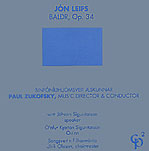AUTHOR'S PREFACE
This work is based on an idea which the author has been developing in his mind over the past twenty years, using an inspiration from the Older Edda. The events of the Second World War and the eruption of the Icelandic volcano Hekla provided ideas for the final dramatic form of the work.
Time and place indicated vaguely as Iceland or Northwestern Europe at the time of the Vikings with a lapse of about fifteen years between Acts I and II.
PROLOGUE TO ACT I
When the curtain rises the stage is enveloped in complete darkness. In the centre front a man is seen in a soft cone of light. It is the figure of a "skáld" who declaims the following prologue:
"Hark, all ye holy kin,
high and low offspring of Heimdal,
I tell ye at the order of Odin
the sacred rites as I remember best.
Hear the speech of the north, cherished and proclaimed by Iceland. Behold the presentation of good and evil as seen by the north from time immemorial.
Behold the sub-humans, animal still and yet hardly animal, waiting in deepest night, seized by lowest impulses, suffering from a mixture of greed and cowardice, envy and malice, swelling to bestiality. A starving old woman and a child chance upon them, only to be robbed and murdered.
Behold how Loki, a god indeed but manifestation of evil, a magician who changes shapes, an associate and producer of all that is vile. He is a guiding spirit. He possesses beauty and cunning. He leads and corrupts the sub-humans. He conjures up his monstrous prodigy to incite them further--Fenris-Wolf, Midgard-Snake and Hel, the goddess of death.
The sea-green figure of Sigyn, Loki's noble wife, cannot deter him from evil until the voice of Odin and the growing light scare him and his children away.
Behold Baldr, the son of Odin, appear in light--the embodiment of human superiority, of good, of conciliation. This god transforms the sub-humans into true humans and softens their animal wickedness.
Behold Baldr's gratification at this influence--his human godliness, his godlike humanity.
Nanna, daughter of Nokki, springs in all innocence to bathe in the stream. Baldr's love is aroused,--but so too is the spying Loki's lust. Loki resorts to every tempter's trick, but Baldr has divine power over Nanna. Loki, filled with envy and hate after his failure conjures up a storm to destroy Nanna and Baldr.
Behold the happiness in love of Nanna and Baldr as the Vikings appear for their athletic games. These athletes do not fight from hate but from love of competing, from pride in their prowess, from their steel-tempered feeling of honour which in joie de vivre cries out: I am.
Behold the battle rise until all have fallen, after which Baldr restores them to new life and bids them prepare a wedding feast for him and Nanna.
Behold Nanna and Baldr mingle their blood under the raised sod, following the custom that has been sacred from time immemorial at the taking of the blood oath. Joyfully the humans take part in the feast."
(The cone of light fades. The figure of the skáld disappears. The play begins.)
PROLOGUE TO ACT II
(After the intermission the Skáld appears before the curtain in a spotlight and speaks the following Prologue:)
"Broadview is the name
of Baldr's palace
where he lives in peace
In his abode
no evil deed
Must ever be committed.
Baldr has been having ominous dreams of his death which Hel is scheming. The Gods meet in order to try to avert the danger. Odin's voice announces that all things, living and dead, must swear to abstain from hurting Baldr and the images of sicknesses, poisons, stones, earth, trees and animals appear to give the oath sealed by Thor's hammer. Only the small Mistletoe is considered too insignificant to swear.
With joyful knockings with his hammer Thor shows that Baldr is immune towards pain and wounds. In great joy the others do the same and prove by experiment that no means will hurt Baldr. Loki is filled with hate and envy and begins to scheme a vengeance in spite of warnings from his wife, Sigyn. He succeeds in inducing Hödr, the blind brother of Baldr, to take part in the playful proceedings and gives him the Mistletoe to throw at Baldr, who is hit and falls dying to the ground. The Einherjar carry his body away on a shield, while his young son comes playing and unsuspecting along.
In a dragon ship on the shore the body of Baldr is to be burned together with his armour, throne, chariot, horse and other things necessary for him on his journey to death. The Gods, the Valkyrias, the Einherjar and the Men say their farewells. Nanna decides to go to her death from sorrow and is placed beside her husband on the ship. Their young son now understands the tragedy. Thor kindles the flame and Odin's voice is heard saying:
Glitnir is the name
of the glorious hall
of gold and silver timbers,
where Forseti shall live
for a long time
and lay fear and feud.
In the glow of the flames Odin appears and inaugurates Forseti, the Son of Baldr, to the duties of his father and leads him to Glitnir, his new abode.
From his hiding place Loki has observed the ceremony. He throws a torch into the smouldering fire and calls forth an earthquake and a volcanic eruption. The wild forces of nature shake Heaven and Earth, while Thor and his brothers chase Loki wildly. The flowing lava forms a cave to which they bring Loki in chains. He is chained to the rocks as formerly his children, the Fenris-Wolf and the Midgard Serpent whose forms appear again. Above Loki they suspend a serpent dropping poison on Loki and each time a drop falls upon him he writhes and causes an earthquake. But Sigyn sits by him with a saucer and catches the drops of poison and thus will she shelter him until the end of the world. Finally we hear a promise of better times to come, expressed by the final chorus:
Unsown fields
shall yield wheat,
evil shall recede
and Baldr shall reappear."
Jón Leifs ca 1950. Taken from the orchestral score.
JÓN LEIFS
Jnó Leifs was born in northern Iceland on May 1, 1899, and died in Reykjavík on July 30, 1968. He began his music studies in Reykjavík (piano and violin), and continued in Leipzig, 1916-1922. His teachers there included the pianist P. Teichmüller and the conductor Hermann Scherchen. During those Leipzig years he also met Ferruccio Busoni from whom he received the encouragement to "follow his own path in composition." In the 1920's Jón Leifs began his studies of Icelandic folk-songs, and in 1925 and 1928 he collected, and recorded a considerable number of them and published his observations in Icelandic or German periodicals. Excerpt for brief visits to Iceland, Jón was active as a composer/conductor in Germany until 1944. Upon his return to Iceland, he became an indefatigable organizer, founding the Icelandic League of Composers in 1945, and nine years later, STEF (the Performing Rights Society). As an almost uncontested president or director of these organizations, he saw to it that Iceland joined their international counterparts, the Berne Convention, the International Music Council, the ISCM, or the Nordic Composers Council, and continued being an untiring writer on various musical subjects.
His compositions, large or small, about 66 with opus numbers, were, except to a very few, mostly unknown until now. Some early pieces were published by Kishner & Siegel in Leipzig, and some by himself (Iclandia Editions) in Reykjavík, but most of them exist only in manuscript. (A complete edition is currently being undertaken as part of the centennial of his birth.)
Thorkell Sigurbjörnsson
| TRACK LISTING |
| |
| COMPACT DISC I |
| |
| 1. Speech |
(3:46) |
| |
| ACT I |
|
| 2. Scene I Dance of the Subhumans |
(16:03) |
| 3. Scene II The Creation of Man |
(4:08) |
| 4. Scene III Nanna |
(4:42) |
| 5. Scene IV Hurricane |
(6:06) |
| 6. Scene V Einherjar |
(1:47) |
| 7. Scene VI The Wedding |
(1:22) |
| 8. Scene VII Dancing--Finale |
(2:31) |
| |
TOTAL TIME = 40:25
|
| |
| COMPACT DISC II |
| |
| 1. Speech |
(4:55) |
| |
| ACT II |
| |
| 2. Scene I Baldr's Dream |
(1:36) |
| 3. Scene II Oathtaking |
(15:11) |
| 4. Scene III Throwing Play |
(3:29) |
| 5. Scene IV Baldr's Death |
(9:48) |
| 6. Scene V Baldr's Cremation |
(9:12) |
| 7. Scene VI Volcanic Eruption |
(6:06) |
| |
| TOTAL TIME = 50:18 |
| |
Baldr, by Jón Leifs, was premiered (in concert form) on March 24, 1991, in Háskólabíó, Reykjavík, Iceland. The recordings took place there March 25-27, 1991.
Publisher: Iceland Music Information Center
Material: Sinfóníuhljómsveit Æskunnar
Producer: Joanna Nickrenz
Engineer: Sigurur Rúnar Jónsson
Editor: Paul Zukofsky
Montage: Elite Recordings
Sinfóníuhljómsveit Æskunnar (the Youth Orchestra of Iceland) was founded in 1985, by Paul Zukofsky, and was a continuation of the "Zukofsky Seminars in Orchestral Music" which began in 1977, and were sponsored by the Reykjavík College of Music. The aim of both groups was to provide an opportunity for Icelandic music students to perform large scale (preferably 20th Century) works that they otherwise would not do. The orchestra is comprised of the students, teacher-coaches, and guests as needed to supply the required complement. Since its founding, Sinfóníuhljómsveit Æskunnar has given the Icelandic premieres of Berg--Wozzeck Excerpts, Bruckner--Symphonies No. 2 & 6, Mahler--Symphonies VI, & IX, Colin McPhee--Tabu-Tabuhan, Messiaen--Et Expecto Resurrectionem Mortuorum, and the Turangalila Symphony, Satie--Relache, Schoenberg--Pelleas and Melisande, and his arrangement of the Brahms--Piano Quartet, and Stravinsky--Orpheus.
Jóhann Sigurarson was born April 21, 1956. In 1981 he graduated from the Iceland School of Dramatic Art, and since them has been acting on stage, in films, television and radio. For the last six years he has primarily worked at the National Theater in Reykjavík, both as a singer and actor.
Ólafur Kjartan Sigurdarson was born September 24, 1968. He studied violin at the Reykjavík School of Music for several years, and was a member of numerous children's choirs. In 1984 he joined the Hamrahlí Choir, of which he was an active member and occasional soloist until 1990. As of 1992, he is a full time student at the Reykjavík School of Singing.
The Söngsveitin Filharmónia (Philharmonic Choral Society) was founded in Reykjavík, Iceland, in 1959, with the aim of performing large choral works with the Icelandic Symphony Orchestra. Söngsveitin Filharmónia has given the Icelandic premieres of Beethoven's Ninth Symphony and Missa Solemnis, Brahms' German Requiem and Verdi's Requiem. Úlrik Ólason has been the choirmaster since 1988.
CP2106/107
© 1991 Musical Observations, Inc.
Warning: Copyright subsists in all recordings issued under this label.
|



